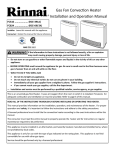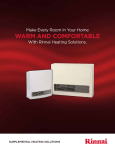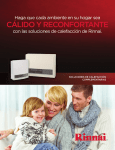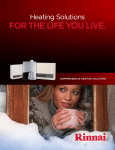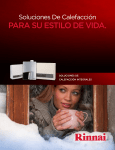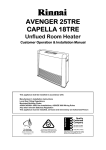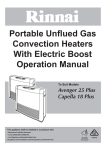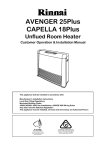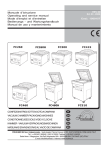Download Rinnai FC824 Specifications
Transcript
Rinnai Fan Convector Heaters Level III Training 1 Fan Convector Heaters FC510 (RCE-391A) FC824 (RCE-691TA) Internal Components FC510 (RCE-391A) FC824 (RCE-691TA) Specifications Product specifications Model Gas Type FC510N (RCE-391AN) Natural Gas FC510P (RCE-391AP) Propane Gas Input Rating Input Rating Btu/hr. HIGH Btu/hr. LOW 10,000 10,000 5,500 5,600 Gas Inlet Pressure Manifold Pressure HI/LO Inches W.C. (mm) 3.5 – 10.5 inches W.C (89 – 267 mm W.C) 1.8 / 0.64 inches W.C. (47 / 16.3 mm W.C.) 8.0 - 13.0 inches W.C. (203 - 330 mm W.C. 3.2 / 1.12 inches W.C. (82 / 28.6 mm W.C.) Fan Motor CFM HI/LO Fuse (Amps) 67.8 Low 97.8 High 5 67.8 Low 97.8 High 5 FC824N (RCE-691TAN) FC824P (RCE-691TAP) Natural Gas Propane Gas 24,000 22,000 8,400 8,000 5.0 – 10.5 W.C (127 - 267 mm W.C) 3.4 / 0.52 inches W.C. (87 / 13 mm W.C.) 8.0 - 13.0 inches W.C. (203 - 330 mm W.C.) 6.3 / 1.00 inches W.C (161 / 25.5 mm W.C.) 109.5 Low 215.4 High 5 109.5 Low 215.4 High 5 Specifications Component/Clearance Specifications FC510 (RCE-391A) FC824 ( RCE-691TA) Gas Connection 1/2" Male NPT 1/2" Male NPT Gas Control Electronic Electronic Burners Ceramic Burner Ceramic Burner Temperature Control Electronic Thermostat Electronic Thermostat Ignition Sdystem Electronic Spark Ignition Electronic Spark Ignition Electrical Connection AC 120V, 60 Hz., 19 Watts AC 120V, 60 Hz., 29 Watts Weight 22.1 Lbs. (10kg) 26.5 Lbs. (12kg) Dimensions Height: 19.4 Inches (492 mm) Width: 19.2 inches (487 mm) Depth: 9.6 inches (244 mm) Height: 19 Inches (482 mm) Width: 24 inches (610 mm) Depth: 9.4 inches (239 mm) Efficiency 99.90% 99.90% Clearances Front 2" Side 2" Top 2" Back 2" Front 2" Side 2" Top 2" Back 2" Ledger Plate Explanation & Warranty • The letters “RCE” indicates this is a “Rinnai Convection Export” heater. • The numbers “510 & 824” indicate the model number of heater. • The letter “T” indicates duel timers on 824 model, no “T” indicates single timer on 510 model. • The letter “A” indicates this is an American version. • The “FC” indicates Fan Convertor Heater. • These units are not suitable for use in bathrooms or bedrooms. Vent-free heaters installed in bathrooms and/or bedrooms must be wall mounted. This product can not be wall mount at the present time. • Product warranty – 3 year parts, no labor. Sequence of Operation 1. Convection fan starts, drawing air in through the back of the cabinet and across the heat exchanger / burner chamber and out into the space. The PCB verifies fan rotation. Thermocouple 1 Gas Valve Solenoids 2. Once the fan is running at the proper speed, spark ignition begins. 3. After spark begins, the gas valve solenoids open allowing gas into the burner. 4. Ignition occurs and flame develops across the burner. Thermocouple 2 Combustion Chamber Spark Electrode POV SV1 5. The PCB will verify flame with thermocouples and turn off the sparker. 6. Warm air then begins to flow into the space. P C B 7. PCB will determine gas input and fan speed settings based on the room temperature measurement from the room thermistor. 8. When thermostat set point is reached the gas valve solenoids close. The combustion fan will continue to run to cool down the unit. 9. When the room temperature drops below the set point, the process will start again. Room Temperature Thermistor Convection Fan Assembly Modulating Technology • Variable speed technology – Modulating gas and air based on the heat loss at that moment • With on/off single stage operation, gas usage can be high due to alternating periods between maximum flame and no flame at all • The Fan Convector modulating technology has the ability to replace only the heat escaping the structure by continuously operating at heating levels based on the demand at that moment On / Off Single Stage Heating Appliance Continuous-Run Modulating Technology 74° 74° 72° 72° 70° 70° 68° 68° 66° Gas Usage Gas Usage Gas Usage • This results in different layers of temperatures throughout the structure leading to a less than comfortable living environment 8 66° Continuous gas usage but at much lower levels • This leads to lower gas usage and higher levels of comfort. Note; if the “Auto Off” function is not selected the unit will run continuously no matter what the room temperature is. Installation Instructions • Do not install this appliance above 2,000ft. • Do not block the warm air discharge. • Do not allow anyone to sleep directly in front of the appliance. • Do not insert items into the louvers. • Do not place clothing or other flammable material on or near the appliance • Do not spray aerosols near the appliance while it is operating. Most aerosols contain butane gas which is flammable. • Do not install this appliance in areas where spray painting or plating is taking place, or in places such as hair salons where there may be large amounts of dust, chemical residue, or debris. Using the appliance in such areas may result in strong odors or irritated eyes and sinuses. • Do not sit on the appliance. Installation Instructions • Do not unplug the appliance while it is operating or while the fan is on. • Do not use a plug in type timer with this appliance. • Do not install in a windy area such as facing a window or a door leading to the outside. • Do not recess this appliance or mount it directly in a wall • If the flooring is carpet, tile, or other combustible material other than wood, then the appliance must be installed on a metal or wood panel extending the full width and depth of the appliance. • This appliance discharges a large volume of warm air next to the floor. Any particles in the air such as cigarette smoke, lint, dust, or debris could cause discoloration in nylon carpets containing dyes or vinyl surfaces. • Rinnai suggests that a dedicated electrical circuit with a 120VAC, 60 hz, 10 amp power source be used. • The flow of combustion and ventilation air shall not be obstructed. • Note that in some regions, an unvented gas heater will increase the amount of humidity in the room. Code Limitations • Check Federal, State and/or local codes in your state before using vent-free products. Some areas of the country do not allow vent-free products. • International Fuel Gas Code Standard 620-6 under “Prohibited Use” states that; “One or more unvented room heaters shall not be used as a sole source of comfort heating in any dwelling unit”. Refer to the International Fuel Gas Code and International Fuel Gas Standard, Charter 6, section 6-11, standard 620-2 for conformation of the above statement. • Code pertaining to bathroom installations. Refer to the 2000 International Fuel Gas Code, section 303.3 “Prohibited locations”. under Exception 3. for prohibited use when installing unvented heaters in a bathroom. It states, “A single wall mounted unvented room heater equipped with an oxygen depletion safety shutoff system and installed in a bathroom provided that the input rating does not exceed 6000 Btu per hour (1.76kW) and the bathroom is not a confined space”. • Code pertaining to bedroom installations. Refer to the 2000 International Fuel Gas Code, section 303.3 “Prohibited locations”. under Exception 4. for prohibited use when installing unvented heaters in a bedroom. It states, “A single wall mounted unvented room heater equipped with an oxygen depletion safety shutoff system and installed in a bedroom provided that the input rating does not exceed 10,000 Btu per hour (2.93kW) and the bedroom is not a confined space”. • The contractor installing this equipment has the responsibility to ensure the product being installed meets all local and State building codes. Please check with your local code officials if you have any questions related to vent-free products. 11 Servicing Fan Convector There’s very little service required on the Fan Convector heaters. Below you will find three items that can be checked and/or cleaned in the event you are experiencing problems with you appliance. NOTE; ALL Service must be performed by a qualified installer, service agency or gas technician. 1. Gas control valve – The gas valve can be checked by verifying the manifold gas pressures are properly set. The manifold gas pressure setting procedures can be found in the technical data sheet under the unit’s front cover. 2. Burner Assembly – The burners are ceramic type burners and should never fail if the unit is not over fired for any reason, dropped or abused. I would recommend that the burner compartment be blown out with compressed air (120 psi) at least annually. This will clear out any foreign matter that has been drawn into the combustion chamber. Low pressure blowers do not generate enough air pressure to properly clean the burner. See the parts breakdown in the Owner’s manual for directions on how to remove the burner’s top plate in order to access the burner. 3. Annual Cleaning – Rinnai recommends that you blow out all compartments inside the unit. In addition, blow out the squirrel cage fan. Care should be taken when blowing out the fan. Keep the air nozzle at least twelve inches away from the fan when blowing it out. Otherwise, high pressure air will cause damage to the fan blades. Maintenance Cleaning Air Filters: Both air filters should be cleaned frequently during the heating season. 1. Unscrew the black cap (Phillips screw in the center of large filter) securing the air filter. Pull the filter up and away from the unit. 2. Remove the small filter simply by pulling the two tabs away from the unit. 2 3. Place both filters in warm water and wash all dust and dirt out the filter. 4. Dry filter with a soft cloth. Make sure they are dried completely before reinstalling in the reverse order as above. 1 Error Codes & Troubleshooting 14 Fault Codes An error code will flash on the unit’s display when a fault occurs. Refer to the list of error codes below for details on your unit’s fault code. All troubleshooting and repairs should be made by a licensed contractor. ERROR FAULT 00 Power Failure 03 Tilt Switch Activated 11 ODS #1 Missed Ignition Burner Sensor Pilot Sensor 12 ODS #1 ODS #2 Flame Failure Burner ODS #1 & Pilot ODS #2 13 ODS #1 Overheat - Burner ODS #1 14 No Ignition (No flame inside burner assembly) Overheat Sensor Thermo fuse 16 Room Overheat REMEDY - Press ON/Off button and allow unit to cycle on. - Return unit to the upright position. Restart heater using the “ON” power button. - Verify the gas supply is turned on to the appliance, gas meter, or tank - Ensure gas type and inlet gas pressures are correct - Bleed all air from gas lines - Ensure gas line, meter, and / or regulator is sized properly - Ensure appliance is properly grounded - Verify ODS #1 and ODS #2 are producing the proper milli-voltage when unit fires. - Inspect all wiring harnesses /connectors for loose, damage or broken connections . - Replace defective ODS sensor - ODS #1 left hand side of burner has sensed an over heat condition. Check filter for blockage first. Then check fan for bad bearing, improper operation or hertz. - Replace ODS #1 Sensor - Verify air filter is in place and not clogged. - Verify proper clearances around the appliance for air flow. Remove any obstructions. - Check gas type of unit and ensure it matches gas type being used - Verify low and high fire manifold gas pressures are properly set. - Ensure DIP switches are set to the proper position on the PC board - Check burner chamber for signs of heat stress, cracks and/or separations - Check burner assembly for damage. - Measure resistance of safety circuit – – Verify unit was sized properly for space being heated. Check for restrictions in air flow around unit. – Check 18 15 Thermocouple #1 – – thermocouple wiring for damage, loose or broken wires. Measure resistance of thermocouple Replace thermocouple Fault Codes – Check thermistor wiring for damage, loose or broken connections or wires. Measure resistance of thermistor Replace Sensor – Short circuit, replace thermistor – 31 32 Room Temperature Thermistor Room Temperature Thermistor – – Check 33 34 62 Overheat Thermistor Overheat Thermistor Combustion Fan Failure – thermistor wiring for damage, loose or broken connections or wires Measure resistance of thermistor Replace Sensor – Short Circuit, replace thermistor – Ensure fan will turn freely Check wiring harness to motor for damaged and/or loose connections Measure resistance of motor windings Replace fan motor – – – – – 70 ON/OFF Switch Faulty – – – 71 Solenoids or Modulating Valve Circuit – – – 72 ODS #1 ODS #2 73 Burner ODS #1 & Pilot ODS #2 initial value abnormal P.C Board abnormal – – Check wiring harness from control panel to P.C board for loose or damaged wires or connections. Replace control panel Check to ensure all gas solenoids or plugged into the solenoid valves. Check to ensure they are plugged into the correct solenoid valve. Check resistance value of all gas solenoid valves Replace defective solenoid. Replace P.C. board. Verify low and high fire gas pressures were properly set. Replace defective ODS Sensor – Press the ON/Off button twice to reset heater Wiring Diagram Electrical Components Values Diagnostic Points Components Convection Fan Motor Mark CFM Wire Colors Value Pin # 3&4 Blue - Brown 10 - 12 VDC Blue - Yellow 2,000 - 5,000 Pulses/Min. (33 - 84 Hz) 2K - 10 KΩ 1&3 Blue - Red 11 - 14 VDC 0.1K - 1 K 2&3 Modulation Gas Valve POV White - Red 1 - 14 VDC 65 - 90Ω 9 & 10 Oxygen Depletion Sensor #1 (TC1) ODS1 Yellow - Blue See next slide for details 5&7 Oxygen Depletion Sensor #2 (TC2) ODS2 Yellow - Blue See next slide for details 1&2 Sparker (IG) IG White - White 96 - 144 VAC 1&2 Gas Solenoid Valves SV1 SV2 Blue - Brown 11 - 14 VDC 35 - 53Ω 1&2 4&5 Room Temperature Thermistor TH Black - Black 50°F (10°C) = 58K - 73KΩ 68°F (20°C) = 33K - 44KΩ 104°F (40°C) = 9K - 19KΩ 1&2 Over Heat Thermistor OH.TH. Black - Black 68°F (20°C) = 70K - 85KΩ 104°F (40°C) = 25K - 40KΩ 158° (70°C) = 8K - 15KΩ 3&4 Thermo-fuse TF White - White Below 1Ω 6&8 Warnings There are a number of (live) tests that are required when fault finding this product. Extreme care should be used At all times to avoid contact with energized components inside the heater. Only trained and qualified service Technicians should attempt to repair this product. Before checking for resistance readings, disconnect the power Source to the unit and isolate the item from the circuit (unplug it). Follow the steps below prior to servicing or replacing any components within the heater in order to protect yourself from harm: • Turn off the electrical power supply by unplugging the power cord or by turning off the electricity at the circuit breaker. (The product’s on/off switch does not control the electrical power). • Turn off the gas at the manual gas valve, usually located behind the unit or within six foot of the appliance. Warnings Failure to correctly assemble the components according to the instructions contained within this presentation May result in a gas leak or explosion Inspect all gaskets/packings for signs of damage or corrosion. Gaskets/packings found to contain damage or that Appear questionable MUST BE REPLACED. Failure to replace damage or questionable gaskets may result in gas leak or explosion. TC1 & TC2 Milli-volt Readings Procedure for measuring TC1 & TC2 Thermocouple Outputs 1. Set voltage meter to read at least 35 milli-volts. Insert meter leads into the output test port holes on the rear of the unit, see below for proper test ports for each thermocouple. FC510 (RCE-391A) Thermocouple Output TC1 (mV) Brown & White TC2 (mV) Black & White Wires Wires Gas Type High Fire Low Fire High Fire Low Fire Propane Gas 23 - 26 16 - 20 23 - 31 16 - 24 Natural Gas 26 - 29 17 - 21 18 - 26 15 - 23 FC824 (RCE-691TA) Thermocouple Output TC1 (mV) Brown & White TC2 (mV) Black & White Wires Wires High Fire Low Fire High Fire Low Fire 23 - 26 16 - 20 23 - 31 16 - 24 26 - 29 17 - 21 18 - 26 15 - 23 2. Fire the unit up and check the milli-volt output on each thermocouple per readings listed above. Readings below those listed above will cause the unit to code out. Verify inlet/manifold high/low fire gas pressures if your readings are not within the specifications as listed above. TC1 test ports - Top is the brown & bottom right is white wire. TC2 test ports - Bottom left is the black & bottom right is white wire. TC1 TC2 Gas Valve Removal Caution: Shut off gas and power supply to the unit before proceeding. 1. 2. 3. 4. Disconnect gas piping to unit at the inlet gas connection shown below. Disconnect the POV gas solenoid valve wiring harness, (red & white wires). Disconnect SV1 & SV2 gas solenoids valves, (blue & brown wires). Remove (1) screw from retainer on the burner gas feed line. Slip retainer off the feed line, pull gas line out of the gas valve assembly. Replace O-ring on this line. 5. Remove (3) screws from the inlet gas connection on the rear of the unit, pull gas vale assembly free from unit. Gas Control Valve Inlet Gas Connection (Rear of Unit) 1 3 2 5 4 P.C. Board Removal Caution: Disconnect the power and gas from the unit before proceeding. 1. Remove (1) screw from plastic P.C. board casing, front of unit 1/3 the way up the unit. 2. Lift up on the P.C. board casing and pull board out of unit. 3. Disconnect all wire connectors from P.C. board. Take care not to stress the connections when unplugging them. Press in on the latch to release the connector before unplugging connection. You can use a small screw driver to push in on these latches. 10 Pin Connector Safety Circuit/POV. 2 Pin Connector Room Thermistor 15 Pin Connector Control Panel Push button used to program gas pressures 6 Pin Connector Thermocouple output terminal on rear of unit Ground wire SV1 & SV2 Connector 4 Pin Connector Fan Motor 2 Pin Connector Igniter 5 amp fuse 2 Pin 120 Volt Power Supply Safety Circuit Caution: Shut off gas and power supply to the unit before proceeding. 1. Burner sensor mounted on the left hand side of the burner assembly is designed to detect the burner temperature. If combustion conditions cause the burner temperature to drop below a predetermined temperature, the sensor will shut the unit off and flash an error code related to the fault. 2. The thermal-fuse located on the top of the burner chamber is designed to shut the unit down in the event the unit senses an abnormal temperature due to improper gas pressure settings, cracked or damaged burner chamber or restricted air flow through the appliance. This safety device activates at 4200F or 216 0C. 3. The overheat thermistor on top of the burner chamber is designed to shut the unit down in the event the unit senses an abnormal temperature due to improper gas pressure settings, cracked or damaged burner or restricted air flow through the appliance. This safety device activates at 131 0F or 55 0C. 4. The pilot burner sensor is located on the right hand side of the burner assembly. This sensor serves as an Oxygen Depletion Sensor or (ODS). If the oxygen level in the room drops below a preset limit, this sensor disables the gas supply to the heater shutting the unit off. 1 3 2 4 Igniter & Igniter Module Removal Caution: Shut off gas and power supply to the unit before proceeding. Igniter/electrode: 1. To remove the igniter unplug the black/green wires from the igniter. The green wire has a latch that has to be pushed in, in order to release the connector. Remove cover plate with (1) screw. 2. Remove (2) screws from igniter bracket assembly, pull igniter/bracket assembly out of unit. 3. Replace igniter gasket before reassembling in reverse order. Igniter Module: 4. To remove the igniter module unplug the wiring harness with two white wires from the PC board. 5. Pull large black wire out of module connection. Remove (1) screw and pull module from unit. 4 1 5 2 Igniter/electrode Igniter module Burner Assembly Removal Next Seven Slides Burner Assembly Removal Caution: Shut off gas and power supply to the unit before proceeding. 1. Remove louver assembly by removing (3) screws as shown below. 2. Remove (2) screws from each side of the front cover, then pull cover away from unit. FC510 FC824 1 1 2 2 Burner Assembly Removal 1. Remove (4) screws on the FC510, (3) on the FC824 ,as shown below. 2. Unplug 15 pin connector from P.C. board. 3. Pull top panel away from unit. 1 1 2 Burner Assembly Removal Caution: Shut off gas and power supply to the unit before proceeding. 1. Disconnect the burner gas line from the gas control valve, (1) screw. Pull retainer clip off burner gas line. Pull gas line loose from the gas control valve. Verify O-ring is intact and in good condition. 2. Unplug the fan motor wiring harness from the P.C. board. 3. Unplug (10) pin safety circuit wiring harness from the P.C. board. 4. Unplug the POV gas solenoid valve. 5. Unplug (2) pin connector at P.C. board for the igniter. 6. Disconnect both ground wires shown below. 1 4 POV solenoid valve 3 10 pin connector for safety circuit 2 4 pin connector for fan motor 5 2 pin connector for igniter Burner gas line 6 Ground wires for PCB and power supply Burner Assembly Removal 1. Remove the (4) screws on the rear of the unit. 2. Remove (1) screw from left side of burner housing down next to floor base. 3. Slide the complete burner and fan assembly out of the unit. 1 1 3 Burner Assembly Removal 1. Remove the burner sensor on the left hand side of the burner housing, (3) screws. Pull the burner sensor retainer clip off the tab. 2. Remove the pilot assembly sensor and burner plate located on the right hand side of the burner housing, (4) screws. 3. Remove the cover plate off the igniter (1) screw and the (2) screws in combustion box. Pull igniter out of unit. 2 1 3 Burner Assembly Removal 1. Remove (2) screws from bracket and pull loose from unit. 2. Remove (4) screws for the combustion box cover and remove cover. 3. Remove (2) screws from burner assembly cover and remove cover. 1 2 3 Burner Assembly Removal 1. 2. 3. 4. Remove (3) screws holding burner assembly to heater housing. Slide burner assembly out of the burner chamber from right side of unit. Complete burner assembly after removed from unit. Install new burner assembly in reverse order. 2 3 1 Cleaning Burner Assembly Cleaning Burner Caution: Shut off gas/power supply to the unit before proceeding. Wear safety glasses to preform task below. 1. Follow procedure for removing burner assembly, with exception to pulling the burner. The burner does not have to be removed to clean it. 2. Inspect burner for damage and/or cracks before proceeding. 3. Blow the ceramic burner out using 120 psi of compressed air. Hold the air nozzle back about six inches from surface during this process. It is recommended the unit be disconnected and moved outside while blowing out the burner due to the amount of dust created by this process. 4. Reinstall ALL covers and the top panel in the reverse order. 5. Restart unit and check to verify it is operating as designed. 1 Cleaning ODS Pilot Orifice Cleaning ODS Pilot Orifice Caution: Shut off gas/power supply to the unit before proceeding. Wear safety glasses to preform task below. 1. Remove front cover on unit (4) screws. 2. Locate pilot and burner orifice on the right hand side of unit, center of burner housing. 3. Blow out the orifices shown in picture 1 with 120 psi of compressed air. Hold the air nozzle back at least six inches from all components to prevent damage from the high pressure air. 4. Install front cover and verify unit operates as designed. Pilot orifice 2 Burner orifice Fan Motor/Squirrel Cage Blower Removal Next Six Slides Fan Motor Removal Caution: Shut off gas and power supply to the unit before proceeding. 1. Remove louver assembly by removing (3) screws as shown below. 2. Remove (2) screws from each side of the front cover, then pull cover away from unit. FC510 FC824 1 1 2 2 Fan Motor Removal 1. Remove (1) holding the igniter module in place and (1) screw holding ground wire in place. 2. Remove (2) screws holding partition board in place. 3. Unplug fan motor from P.C. board. 2 1 3 Fan Motor Removal 1. 2. 3. 4. Remove (2) screws on the rear of unit. Remove (2) screws on left side of burner housing. Remove (2) screws on right side of burner housing. Slide fan motor and housing assembly out of the unit. 3 1 2 Fan Motor Removal 1. Remove (4) screws holding fan motor to unit’s housing. 2. Loosen screw on fan motor shaft and pull fan motor loose from unit. 2 1 Squirrel Cage Blower Wheel Removal 1. Remove (2) screws on squirrel cage bearing housing assembly, left hand side of unit. Remove bearing housing. 2. Loosen screw on fan motor shaft, right side of unit. Slide blower wheel out of unit from left side of unit. 3. Reassemble in the reverse order. 2 1 The End Fan Convection Heater Service Training 44












































